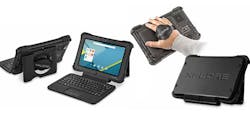The modern manufacturing plant is teeming with complexity, with technicians and engineers asked to do more every day, wading through operations on the floor or in the field for a while, then diving deep into data or emails in the office.
In the future, maybe everyone will have smartglasses or robotic personal assistants to help interface with all the connected machines and management systems, but for now, a laptop or tablet by your side seems like the best option.
The problem is, no one wants to schlep around the production line with an open laptop, dodging errant beads of oil or metal shavings that could damage it. Conversely, tablets' touch screens are great for slingshotting birds at pigs or crushing candy, but try writing a lengthy report to the big bosses with a stylus or your finger.
But why choose, or constantly swap devices for mobile and stationary work? With the XBOOK B10 detachable 2-in-1 mobile computer, made by leading rugged computer manufacturer Zebra Technologies, you don’t have to.
On the floor or jobsite, detach the spill-resistant keyboard, slip your hand into the adjustable hand strap attached, and pull the corded Wacom active digitizer pen out of its slot to enter data or log a problem. The IP-65 rated device works when wet and also with gloves.
When you sit down for lunch to write a detailed report, click the keyboard back in and pull out the kickstand for traditional laptop operation. The versatility, without sacrificing performance, makes it the Nintendo Switch of hardcore industrial computing.
The enterprise-grade "mobile office" comes with an Intel Broadwell generation Core-Series processor, 8 GB RAM, and 128 or 256 GB SSD, and promises eight hours of battery life (up to 20 if you hot-swap the optional second battery). It comes with Windows 10, so AI assistant Cortona can help out by following voice commands or reading out work instructions.
Consumer 2-in-1's can do much the same computing, but the hardware and hard shell are why you'd spend more than $2,000 on the XBOOK B10.
First off, there's the magnesium alloy midframe. Magnesium is lighter than aluminum and stronger than steel, so it's easy to carry but hard to break. The 2.4-pound weight is more than double an iPad and a touch more than a Microsoft Surface, but half of the Lenovo laptop used to write this.
"Magnesium is not the cheapest material, but it provides a rigid stiff structure which is why the device can withstand the shock but also vibrations," says Tom Kost, the company's director of product marketing.
He says even when mounted in a bouncing truck or forklift, the secure structure keeps the motherboard from shaking loose or connectors breaking off.
The frame and overall design allow the computer to survive a 5-foot drop, earning a MIL-STD-810G certification. The device was tested at 26 different angles, from each corner to flat on the screen. Zebra grades on even more stringent standards than necessary to receive a passing grade. Typically, if the screen cracks but no data was lost, the device passes.
"For me, that seems unreasonable, because if the screen cracks you can’t use the data," Kost says. "That's not good enough for Zebra. We'll accept cosmetic damage, but not a crack."
Like gravity, extreme temperatures also can’t bring the B10 down. The tablet, which still works at -34°C, can go from a sweltering Phoenix parking lot to a freezer without missing a beat, or byte.
In traditional manufacturing, XBOOK has found a niche as a tough, reliable interface between the Industrial Internet of Things and the worker. RFID and bar code scanners are available accessories.
The potential for augmented reality applications is currently being investigated with a partner in the enterprise AR software space. A plant engineer could quickly see RPM or vibration data, and maintenance tech could point the tablet at a valve to prompt repair instructions to pop up.
A major German automaker has deployed the B10 on mobile carts to follow and keep track of the car, providing custom work instructions to each station. If a part is needed, it can be ordered automatically from the warehouse.
"They have hundreds of cars going down the line, serpentining throughout the building," describes Kost, who visited the complex. "They used to have huge stacks of papers. Now they are moving towards a paperless factory."
This obviously reduces paper costs, but without having to search through reams of instructions to install a certain stereo system, or finding out a paper is missing, prevent actual assembly of the car
The undisclosed company makes a million cars a year and Kost ballparks that this could speed up production by 5%.
Aside from Industry 4.0 benefits, the simple toughness of the computer provides its own ROI, Kost says. An outside agency conducted a total cost of ownership study and found even a $600 iPad ends up being more expensive over five years, the expected life of the B10.
"Every time a device breaks, you may or may not lose data, but for sure the worker can’t do his job," explains Kost, who then provides the litany of actions an IT manager must complete getting the computer back on the floor. The study takes into account the IT manager's time, which isn’t usually considered.
"Those back-end costs end up costing a lot more," Kost says. "The total cost of ownership ends up being about half."












